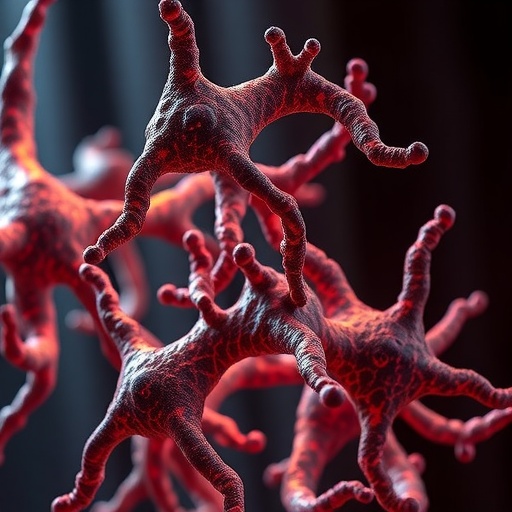Recent advancements in pediatric oncology have revealed groundbreaking insights into the mechanisms underpinning pediatric Wilms tumor evolution. A study authored by A.L. Hong and E.A. Mullen delves deep into this enigmatic form of kidney cancer, which primarily affects children. By employing innovative research methodologies and models, the findings challenge long-held assumptions about tumor development and progression in young patients. This research is poised to alter the landscape of pediatric oncology, prompting both clinicians and researchers to reconsider existing treatment strategies.
Hong and Mullen’s work critically examines the genetic and epigenetic factors contributing to the pathogenesis of Wilms tumor. These tumors, characterized by their embryonic origin, exhibit an array of genetic alterations that underscore the complexity of their development. The novel model presented by the authors posits that the evolutionary trajectory of these tumors may not be linear but rather resemble a multifaceted journey. This paradigm shift is essential for enhancing our understanding of tumor biology and personalizing treatment approaches for affected children.
One of the standout elements of the research is the emphasis on the tumor microenvironment. The interplay between cancer cells and the surrounding stroma can significantly influence tumor growth and response to therapy. Hong and Mullen argue that traditional models often overlook this critical aspect, which may be contributing to suboptimal treatment outcomes. By factoring in the microenvironment, the authors advocate for a more holistic approach to cancer treatment that considers not just the tumor itself but also its ecosystem.
The study also highlights a range of potential therapeutic targets stemming from the newly identified genetic alterations within Wilms tumors. Through high-throughput sequencing and comprehensive bioinformatics analyses, the authors were able to identify key pathways that are aberrantly activated in these cancers. This knowledge positions researchers and clinicians to explore targeted therapies that could improve survival rates and quality of life for pediatric patients.
Moreover, the research underscores the importance of early detection and intervention. With the help of advanced imaging techniques and biomarkers, oncologists may be able to identify Wilms tumors at an earlier stage than ever before. Early intervention has the potential to drastically alter the prognosis for affected children, making it crucial for the medical community to employ novel detection strategies as part of standard clinical practice.
The authors also discuss the implications of their findings for future research endeavors. They call for collaborative efforts among researchers, clinicians, and families affected by Wilms tumors to foster innovation in the field. By pooling resources and expertise, the scientific community can accelerate the development of novel therapies and improve patient outcomes. Encouraging a culture of collaboration may prove essential in addressing the complex challenges posed by pediatric cancers.
Educational initiatives are also identified as paramount in the fight against pediatric Wilms tumor. Empowering both healthcare providers and families with knowledge about the disease can lead to more informed decision-making and improved treatment adherence. The authors advocate for developing educational materials and resources that demystify the condition and promote a better understanding of its genetic basis.
In a world increasingly attuned to the multidisciplinary nature of cancer research, the importance of combining insights from genetics, molecular biology, and clinical practice cannot be overstated. Hong and Mullen make a compelling case for the integration of these diverse fields to derive a comprehensive understanding of Wilms tumor. Such an integrative approach aligns well with current trends in personalized medicine and offers a pathway towards more effective treatment paradigms.
The authors also delve into the psychosocial aspects surrounding pediatric cancer care. Beyond the biology of Wilms tumors, understanding the emotional and psychological implications for children and their families is crucial. Addressing the mental health needs of patients and caregivers should be an intrinsic part of treatment plans, providing holistic care that prioritizes well-being alongside physical health.
The notion of precision medicine is not lost on Hong and Mullen. Their findings reinforce the necessity for individualized treatment strategies that reflect the unique genetic makeup of each tumor. As the field progresses, the ability to tailor therapies to specific genetic and genomic profiles will likely become central to optimizing outcomes for pediatric cancer patients. The future of Wilms tumor management rests on understanding the distinct characteristics of individual tumors and responding accordingly.
As the authors conclude, the fight against Wilms tumor is far from over. The insights gleaned from their research lay a robust foundation for ongoing investigations and clinical application. By challenging existing paradigms and proposing new models of tumor evolution, this study may well steer the future course of pediatric oncology. It is a call to action for researchers, clinicians, and advocates to unite in the pursuit of better outcomes for children facing this formidable adversary.
In summary, the work of Hong and Mullen is a clarion call for transformation and innovation in the realm of pediatric Wilms tumor research and treatment. By prioritizing a comprehensive understanding of tumor evolution, treatment personalization, and collaborative efforts, we can hope to alter the trajectory of this childhood cancer and ultimately improve the lives of those affected.
Subject of Research: Pediatric Wilms Tumor Evolution
Article Title: Finding a brush when you expect a broom: a novel model of paediatric Wilms tumour evolution.
Article References:
Hong, A.L., Mullen, E.A. Finding a brush when you expect a broom: a novel model of paediatric Wilms tumour evolution.
Nat Rev Urol (2025). https://doi.org/10.1038/s41585-025-01082-y
Image Credits: AI Generated
DOI:
Keywords: Pediatric oncology, Wilms tumor, tumor evolution, cancer research, targeted therapies, genetics, precision medicine, early detection, collaborative research.




